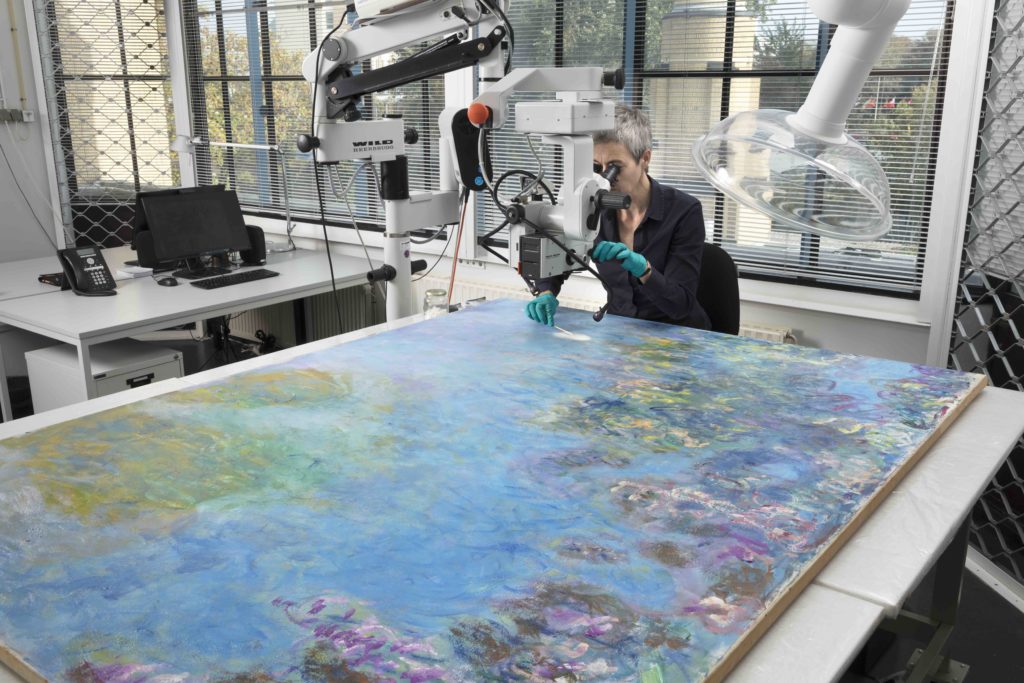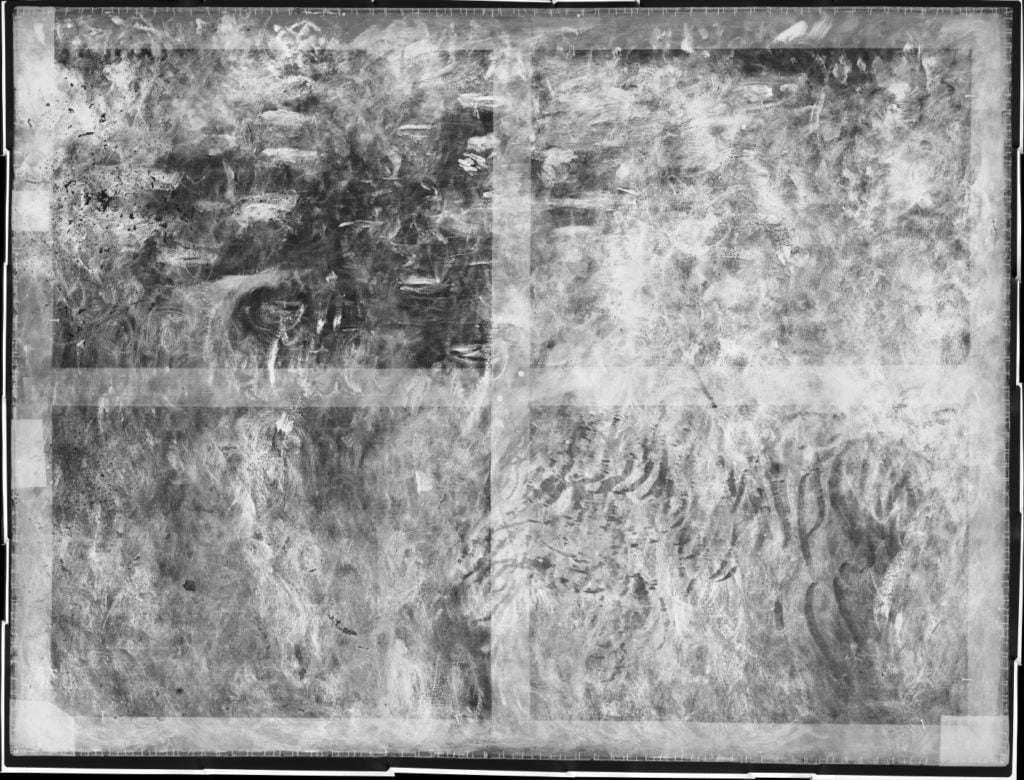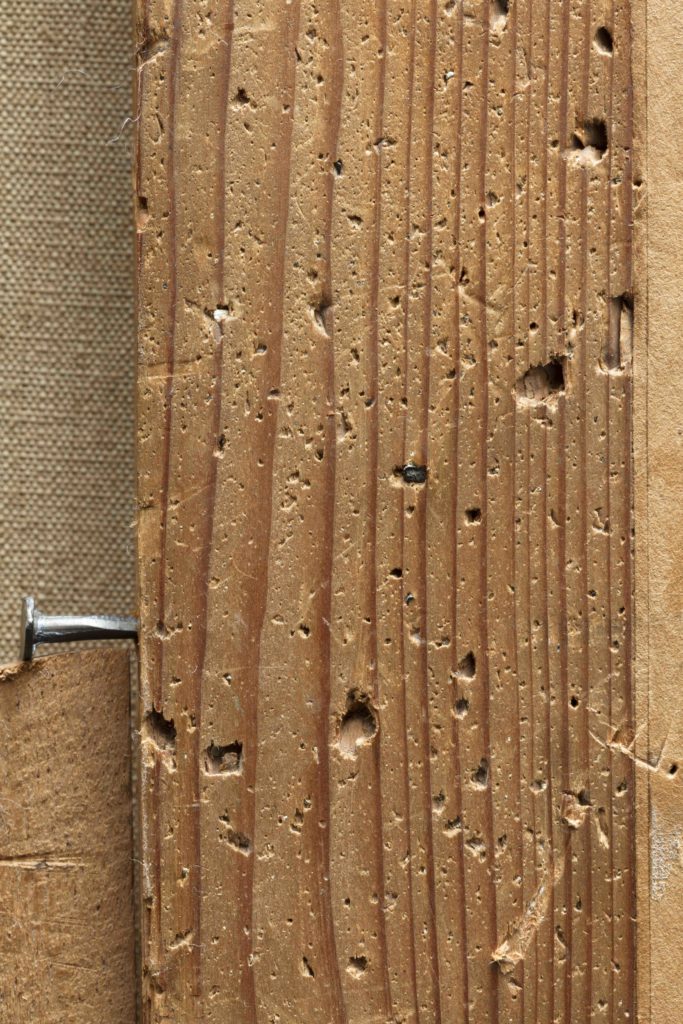Art & Exhibitions
A Dutch Conservator Made the Discovery of a Lifetime When She Found That Monet Hid Water Lilies Beneath a Lesser-Known Painting
See the x-ray of the previously unknown composition here.

See the x-ray of the previously unknown composition here.

Naomi Rea

Claude Monet’s “Water Lilies” series is coveted by museums and private collectors worldwide. But one Dutch museum owned one without even knowing it.
Experts at the Gemeentemuseum in the Hague discovered a previously unknown version from the famous series hidden beneath a later painting of wisteria flowers by the artist. The museum made the astonishing find last month after its experts spotted something unusual about the painting’s newly cleaned surface, prompting a conservator to X-ray the canvas.
“We discovered a lot of teeny tiny in-painted parts concealing very small damages to the painting,” the museum’s head of collections Doede Hardeman tells artnet News. These retouches covered up small holes created by broken glass, a few remaining shards of which were embedded within the painting’s wooden stretcher. But it wasn’t until Hardeman’s colleague, restorer Ruth Hoppe, X-rayed the painting to get a better look at the damage that she made the incredible discovery of the water lily painting beneath the wisteria blossoms.
Ahead of an exhibition of Monet’s garden-inspired paintings, Hoppe worked with the museum’s curators as well as experts from institutions including the Museum of Modern Art in New York and the Fondation Beyeler in Switzerland to examine the painting for the better part of a year. Wisteria (1917–20) is one of only seven works (including one diptych) that Monet created to hang above a frieze above his famous cycle of large water lily paintings, which he offered to the French nation the day after the Armistice in 1918 as a memorial to the war.

Claude Monet, Wisteria (1917-20). Image courtesy of the Gemeentemuseum.

The X-ray of Claude Monet’s Wisteria painting shows a hidden version of his “Water Lily” series. Image courtesy of the Gemeentemuseum.
Hoppe made the startling discovery in May, after spending months painstakingly removing the varnish added to the work after World War II. The new research has broader implications for our understanding of the artist and confirms the theory that his studio at Giverny just narrowly avoided destruction during the war.
The shards of glass discovered in Wisteria’s stretcher support the idea that damage to some of Monet’s other works, including the “Water Lilies” triptych in MoMA’s collection, was caused when the glass roof of the studio shattered during heavy fighting in the area. A 1959 conservator’s report notes damage to the MoMA work, which was stored next to the Gemeentemuseum’s Wisteria painting at Giverny.

Shards of glass from the studio roof at Giverny were found embedded in the painting’s stretcher. Image courtesy of the Gemeentemuseum.
“It feels like we are building a new, small part of art history,” Hardeman says. The new findings add “incredible” historical value to the work, he adds. The discovery also lends credence to the theory that the Dutch museum’s Wisteria could be first in the series, serving as a link between the better-known water lilies and the lesser-known and later wisteria works. Experts suspect that Monet, who did not typically reuse canvases, may have covered up this final water lily painting with this new wisteria composition as an early experiment.
Today, Monet’s water lily paintings are some of his most famous works, but for decades they were out of fashion. When his great war memorial was unveiled in the Musée de l’Orangerie in Paris in 1927 shortly after the artist’s death, Impressionism seemed passé. Interest in the series revived in the ’50s as museums began to reevaluate the work and American artists, including Mark Rothko and Ellsworth Kelly, cited them as inspiration. This new find may boost the profile of the wisteria series a bit closer to the more famous water lilies.
The Dutch museum’s painting is already considered a highlight of its collection. It has been on continuous display since it was acquired in 1961 from the Swiss art dealer Ernst Beyeler.
Wisteria and the new research will be the centerpiece of the exhibition “Monet: The Garden Paintings,” which opens on October 12 and runs through February 2, 2020 at the Gemeentemuseum, which is due to be rebranded shortly as the Kunstmuseum Den Haag.
“Monet—The Garden Paintings” is on view October 12, 2019, through February 2, 2020 at the Gemeentemuseum in the Hague.